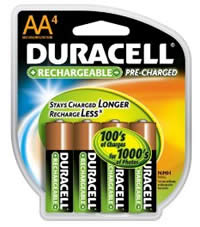Difference between Rechargeable and Non-Rechargeable Batteries
Key Difference: Rechargeable batteries consist of one or more electrochemical cells and are a type of energy accumulator. It is known as a secondary cell as it has the ability to be recharged and reused. Non-rechargeable batteries as the name suggests cannot be recharged for multiple uses. The battery can be used only once after which it should be discarded. These batteries are known as primary batteries as the process which powers the device is irreversible.
Batteries have become an important invention to the society. Imagine a world without batteries, nothing would be portable! Having to walk around with a phone that works only when connected to an electrical outlet and there would be no flashlights when there isn’t electricity. If everything ran on electricity, the amount of wires that would be around would be annoying and hazardous. Batteries have been constantly been evolved to get a longer lasting battery. Each battery has been tried and tested with different materials to see which would provide a better charge. There are two types of batteries, rechargeable and non-rechargeable. Rechargeable batteries are batteries that can be recharged for multiple usage, while non-rechargeable batteries can only be used once.
 Batteries have been around since ages, though the batteries that we know now were invented by Alessandro Volta during the 1800s. The electrochemical cell that goes into building a normal AA size battery was discovered by Luigi Galvani in 1780, when he connected two different materials (copper and zinc) and connected both to different parts of a nerve of a frog’s leg, which caused the leg to contract even after the frog was dead. He dubbed this as ‘animal electricity’. However, this wasn’t the first cell that was invented. The earliest known battery was dated back to ancient Parthia, where jars full of citric acid or grape juice were used to produce a voltage. There were termed as the Baghdad battery and the German director of the National Museum of Iraq Wilhelm König claimed in 1940 that these were similar in workings to a galvanic cell. Let’s understand how the battery works.
Batteries have been around since ages, though the batteries that we know now were invented by Alessandro Volta during the 1800s. The electrochemical cell that goes into building a normal AA size battery was discovered by Luigi Galvani in 1780, when he connected two different materials (copper and zinc) and connected both to different parts of a nerve of a frog’s leg, which caused the leg to contract even after the frog was dead. He dubbed this as ‘animal electricity’. However, this wasn’t the first cell that was invented. The earliest known battery was dated back to ancient Parthia, where jars full of citric acid or grape juice were used to produce a voltage. There were termed as the Baghdad battery and the German director of the National Museum of Iraq Wilhelm König claimed in 1940 that these were similar in workings to a galvanic cell. Let’s understand how the battery works.
A battery is made up of multiple electrochemical cells. An electrochemical cell consists of two half-cells. Each half-cell consists of an electrode and an electrolyte. The two half-cells could use same electrolyte. During the reaction, the species from one half-cell lose electrons (oxidation) to their electrode while the species other half-cell gains electrons (reduction). The two halves are connected by a salt bridge or porous disk that is employed to allow ionic contact between the two halves without mixing the solutions. As the electrons are transferred from one side to the other, the difference in charges are established. The salt bridge allows the ions to maintain a balance between the oxidation and reduction. The two electrodes are known as the anode and the cathode and both are connected to a high resistant voltmeter. The voltmeter helps the electrodes to maintain a voltage. The difference between the charges is then converted in to electrical energy to be used in portable gadgets.
Rechargeable batteries consist of one or more electrochemical cells and are a type of energy accumulator. It is known as a secondary cell as it has the ability to be recharged and reused. The reactions inside the cell that causes the batteries to provide power can be made using a number of different materials. This reaction can be reversed using electricity for a number of uses. When the batteries are recharged, the positive active material is oxidized and the negative material is reduced. The electrolyte between the two materials could serve as a as a simple buffer for internal ion flow between the electrodes or may play an active part in the electrochemical reaction. The batteries require a proper battery charger that uses either AC or DC electricity to charge the batteries. Depending on the charger, batteries may take anywhere from 4-14 hours to charge. Though rechargeable batteries can be reused multiple times, it often has a limited lifecycle and can only be recharged a number of times. Rechargeable batteries have a higher initial cost, but are cheaper in the long-run. Rechargeable batteries are made using a number of different materials such as Lead–acid, Nickel–iron, Nickel–zinc, Lithium-ion, sodium-ion, etc. The most common rechargeable batteries are Nickel–cadmium battery (NiCd), Nickel–metal hydride battery (NiMH), Lithium-ion battery and Lithium-ion polymer battery. These batteries are becoming increasingly popular in many applications including cell phones, electric vehicles, motorized wheel chairs, flashlights, etc.

Now, non-rechargeable batteries have a much simpler process compared to recharge-able batteries. Non-rechargeable batteries as the name suggests cannot be recharged for multiple uses. The battery can be used only once after which it should be discarded. These batteries are known as primary batteries as the process which powers the device is irreversible. Non-rechargeable batteries produce electric currents upon assembly, the moment it is finished. The chemical reactions which produce electricity can only go through one process. Once that process is finished, the battery is rendered useless and is discarded. These batteries are perfect for use devices that require little current to work such as alarms, smoke detectors, clocks, etc. Non-rechargeable batteries cost less, but are less economical in the long run. These batteries are also perfect for long-term storage purposes as they have a slower deplete rate than secondary cells making them perfect for emergency situations. In case of emergency kits, it is often advised to have a pack of primary batteries that may be required for flash lights and radios. The batteries can also be stored at lower temperatures to slow down the chemical reactions in the battery making it much easier to store. Secondary cells are available in various different shapes and sizes for different usage and are used in a variety of applications including cameras, clocks, alarms, camcorders, etc.
The amount of non-rechargeable batteries that are available in the market and are discarded on a daily basis is causing environmental concerns. Battery manufacturers often consume resources that include hazardous chemicals. These chemicals create toxic environment in the air. The used batteries that are discarded also add to electronic waste. Many companies and governments have started taking initiative to recycle and create recycled batteries to reduce waste and pollution.
Image Courtesy: sodahead.com, philips.com.au









Add new comment